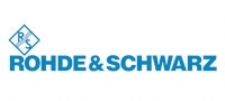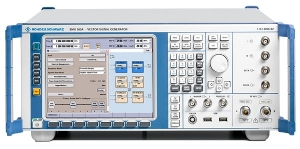Novos e Usados
SMU200A

|
Rohde & Schwarz |
Description
The R&S®SMU200A Vector Signal Genereator not only combines up to two independent signal generators in one cabinet of only four height units, it also offers unrivalled RF and baseband characteristics. The genetator has been designed to meet all requeriments encoutered in research and development of modern communication systems as well as in their production.
Key Facts
- First RF path from 100 kHz to 2.2/3/4/6 GHz
- Optional second RF path from 100 kHz to 2.2/3 GHz
- Up to two complete baseband paths
- Support of 3GPP LTE FDD and TDD, 3GPP FDD/HSPA/HSPA+, GSM/EDGE/EDGE Evolution, TD-SCDMA, WiMAXâ„¢ and all other important digital tandards
- 2x2 MINO with realtime fading possible
- Two instruments combinable for 2x4 or 4x2 MINO
- I/Q modulator with 200 MHz RF bandwidth
- Optional baseband generator with realtime coder and arbitrary waveform generator
- Outstanding RF performance
Characteristics
THe vector Signal Generator R&S®SMU200A has been designed to meet all requirements encountered in research and development of modem communication systems as well as in their production. The R&S®SMU200A not only combines up to two independent signal generators in one cabinet of only four height units, it also offers unrivalled RF and baseband characteristics.
Due to its modular desing, the R&S®SMU200A can be optimally adapted to the requirements of different applications. Thge first RF path can be equipped with one of the four available frequency options. The upper frequency limit of 2.2 GHz / 3 GHz / 4 GHz or 6 GHz is user-selectable. In addition, a second RF path can be installed with upper frequency limits of 2.2 GHz and 3 GHz the lower frequency limit of all frequency options is 100 kHz.
Up to two generators can also be installed in the baseband section. They generate complex signals in realtime and are equipped with an arbitrary wavefrom generator with up to 128 Msample memory for I and Q (512 Mbyte). The signels generated in the different basebands can be added. Frequency offset of the individual signals is possible. The optional internal fading simulator provides up to 40 fading paths for simulating multipath propagation.
The R&S®SMU200A can be fitted with a wide range of options - for example, options for all of todays important digital standards as well as function and performance enhancements such as MINO fading or phase coherence.For a list of all available options as well as links to detailed information about the individual options, see "ordering information".
The modern, intuitive concept of the R&S®SMU200A ensures fast and easy operation.
Two signal generators in one
- Frequency options from 100 kHz to 2.2/3/4/6 GHz for the first RF path
- Optional second RF path up to 2.2 GHz
- Up to two complete baseband paths
- Lossless combination of baseband signals in the digital domain (e.g. for testing multistandard base stations)
Outstanding signal quality
- I/Q modulator with 200 MHz RF bandwídth
- Very low SSB phase noise of typ. -135 dBc (f = 1 GHz, 20 kHz carrier offset, 1 Hz measurement bandwidth), typ. -139 dBc with the enhanced phase noise performance option
- Wideband noise of typ. -153 dBc (CW, f = 1 GHz, >10 MHz carrier offset, 1 Hz measurement bandwidth)
- Excellent ACLR of typically +70 dB for 3GPP FDD
- Very high level repeatability of 0.05 dB
- High output power up to +19 dBm (PEP), overrange + 26 dBm
- High-stability reference oscillator as standard
Unrivaled flexibility
- 2x2 MINO with realtime fading possible
- Two instruments can be combined for 2 x 4 or 4 x 2 MINO
- Optional fading simulator with up to 40 fading paths
- Support of EUTRA/LTE FDD and TDD signal generation
- Support of WiMAXâ„¢ IEEE 802.16-2004/Corr1-2005, 802.16e-2005 and WiBro
- Four code channels in realtime for 3GPP FDD, support of HSDPA and HSUPA
- Mixed frames with GSM, EDGE and EGPRS2 slots in one frame (with same symbol rate per frame)
- Baseband generator with universal coder for realtime signal generation
- Arbitrary waveform generator with 16 Msamples, 64 Msamples or 128 Msamples
- Arbitrary waveform generator supported by R&S®WinIQSIM2â„¢ and R&S®WinIQSIMâ„¢ simulation software
Intuitive operation
- Color display with 800 × 600 pixels (SVGA format)
- Intuitive user interface with graphical display of signal flow (block diagram)
- Graphical display of baseband signals through built-in transient recorder
- Context-sensitive help system
Ideal for production
- Very short frequency and level setting times (<2 ms); only 450 µs in List mode
- Electronic attenuator up to 6 GHz over the full level range
- Flexible high speed measurements with RF List mode and multisegment waveforms
- Minimum space required as two complete generators are accommodated in one instrument of only four height units
Connectivity
- Optional digital I/Q input and output; support of R&S®EX-IQ-Box for flexible data formats and clock generation
- Support of R&S®NRP power sensors
- Remote control via LAN (Gigabit Ethernet, VXI11) and GPIB
- Remote operation via Windows Remote Desktop or VNC
- User-selectable trigger and marker signals
- USB connectors for keyboard, mouse and memory stick
- LXI class C compliance
Features
Intuitive operation
The R&S®SMU200A is equipped with a modem and intuitive user interface. The signal flow from the baseband to the RF output is clearly shown in the block diagram. Each block represents a functional unit the instrument. The generated signal can be seen at a glance, and whether it is affected by additive white Gaussian noise and/or fading.
Outstanding signal quality
Owing the sophisticated multiloop synthesizer concept, the R&S®SMU200A features extremely low SSB phase noise and wideband noise. A high-stability oven-controlled reference oscillator is installed as standard, which provides excellent aging characteristics as well as minimum temperature drift. The R&S®SMU200A is ideal, for instance, for LO or VCO substitution.
Amplifers of 3GPP base stations require very good adjacent channel leakage ratio (ACLR) performance in order not to impeir the adjacent channels of the transmission. To test feature, the ACLR characteristics of the signal generator must be better than those of the amplifier. Presently, multicarrier power amplifiers are increasingly used. In this case, not only one but several neighbouring signals in the frequency range are amplified. Testing such amplifiers even higher demand on signal generator capabilities, The outstanding ACLR characteristics of the R&S®SMU200A more than qualify the generator for this task.
Unrivalled flexibility
The stendards of the third mobile radio generation set considerably higher demands are the instrument of choice particularly when base stations are tested. The universal coder in the baseband generator of the R&S®SMU200A has been designed for easy implementation of new standards. The R&S®SMU200A is therefore well prepared for present and future mobile radio standards.
Up to two signal generators in one
All the strenghts of the two-path concept of the R&S200A become especially evident in the field of mobile radio. Since the baseband section of the R&S®SMU200A is fully digital, the signals of the two baseband
generators can be easily added without synchronization problems and without an extarnal coupler or or additional equipment being required. A frequency offset and the relative power of each signal can be accurately set.
For receiver tests in multicarrier base stations with complex interfering signals, one baseband generator can produce the test signal to be evaluated. The second baseband generator produces a suitable multicarrier signal to be used as the background signal. Two transmit antennas (the transmit diversity) of a base station can also be simulated. Up to now, two signal generators have been required in this case, but only one instrument is needed when the R&S®SMU200A is used.
Ideal for production
Short turnaround times and short test times are important particularly for automatic test sequences in production. Short setting times of a signal generator mean money in hand. The R&S®SMU200A with its very short frequency setting time of <2 ms meets all requirements. In the List mode, where frequency variations have previously been stored in a list, the setting time is reduced to <450 µs. A built-in electronic attenuator ensures wear-and-tear-free switching. This prevents down-times for replacing mechanical attenuators.
Connectivity
- Remote control
The R&S®SMU200A is remote-controlled via GPIB or LAN. When the Windows Remote Desktop is used, the instrument can be remote-operated from a PC. - Front panel
An external keyboard and a mouse or memory stick can be plugged to the USB connectors on the front panel. Two marker outputs that can be used as required and a trigger input are available in addition. - Rear panel
A LAN (100BaseT) and a GPIB interface as well as a USB slave connector are available at the rear. Using the slave connector, the R&S®SMU200A can be directly connected to a PC, e.g. for loading firmware s in a fast and convenient way. Even modulation data from a PC can be fed in via this connector. An external monitor or a video projector can be connected to the VGA connector. - Future-oriented
Owing to its modular design, the R&S®SMU200A is a safe investment. Options can be added any time. This concept allows the R&S®SMU200A to be tailored to specific applications.
Venda, Locação, Manutenção e Calibração
Rua Rodrigues Barbosa, 72 Tatuapé São Paulo - SP CEP 03334-040




